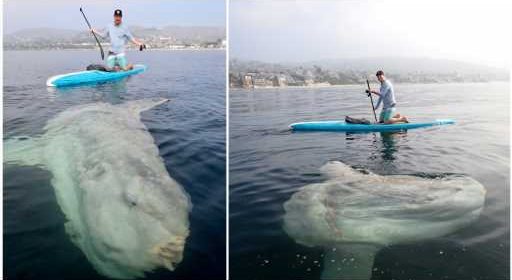This “bizarre” creature is a massive sunfish spotted near Laguna Beach – The Denver Post

A pair of paddlers encountered a massive sunfish just a few hundred yards off Laguna Beach’s shoreline that could rival in size a Guinness World Record set in 1996.
Rich German and friend Matt Wheaton, both of Laguna Beach, set out on Thursday, Dec. 2, to enjoy the clear waters off the coast. They came across a massive mola mola, also known as sunfish, floating on the ocean’s surface.
“We were just paddling and all of a sudden we were like ‘Oh my god.’ That thing was massive,” said German, author of the book “Blue Laguna” and founder of the ocean conservation nonprofit Project O. “Most of my encounters are with dolphins and whales, but you never know what you’re going to see.”
German, comparing to Wheaton’s 14-foot stand-up paddleboard, guessed the fish was close to 9 feet in length.
Once home, he found a Guinness World Record set in 1996 when a fisherman caught an 8-foot-11 mola mola that weighed 5,070 pounds off the coast of Japan. While that record was for the heaviest fish, which would be tough to compare with the sunfish the pair encountered off Laguna Beach, German said he thinks theirs could be longer in length and is hoping to consult with marine scientists to see if it could be measured based on the size of the board.
Julianne Steers, founding board member of the Beach Ecology Coalition, said the sunfish was larger than most seen here – she’s seen fish about 6- to 7-feet long. But whether it was a record-holder would be tough to tell.
“The only true way to know is if it was out and weighed and officially measured,” she said, noting that there’s some records up in Northern California of sunfish reaching 13-foot long. “But it does look much larger than what we typically see out here.”
She called the mola mola a “lumbering” fish that likes to lazily float on the ocean’s surface to bask in the sun, hence their nickname, eating jellyfish and salps.
The species looks like a mad scientist put them together with spare parts, Steers said. “It’s such an oddball kind of assembly of parts.”
The mola mola is also the largest fish in the world that has a skeleton structure, she said.
Stand-up paddler Matt Wheaton gets up close with a massive sunfish he estimates was at least 9 feet off Laguna Beach on Thursday, Dec. 2. (Photo courtesy of Rich German)
Ocean sunfish, also known as mola mola, are the largest bony fish in the sea. (Photo courtesy of Rich German)
Stand-up paddler Rich German gets up close with a massive sunfish he estimates was at least 9 feet off Laguna Beach on Thursday, Dec. 2. (Photo courtesy of Matt Wheaton)
Stand-up paddler Matt Wheaton gets up close with a massive sunfish he estimates was at least 9 feet off Laguna Beach on Thursday, Dec. 2. (Photo courtesy of Rich German)
Stand-up paddler Matt Wheaton gets up close with a massive sunfish he estimates was at least 9 feet off Laguna Beach on Thursday, Dec. 2. (Photo courtesy of Rich German)
Scientists once thought the mola mola drifted with ocean currents, but they’ve been tracked in Southern California swimming 16 miles a day at a top speed of 2 mph, the Monterey Bay Aquarium says on its website.
“With its tank-like body, the mola was clearly not built for life in the fast lane. But it holds its own against faster and flashier fish and is able to live in almost all of the world’s oceans,” the aquarium says. “It’s known to spend time near the surface, but tagging shows that the mola is also a prolific diver and migrates long distances at depth.”
German said he has seen many mola molas through the years, but typically further offshore and about half the size of the one encountered just south of Main Beach.
“The first time I saw one, I didn’t know what it was. I thought it was a mutilated shark,” he said, noting the fish’s fin often stands up above the surface. “They are so bizarre looking. They just lay there.”
Even if it’s not an official record-setter, German is still soaking in the interesting encounter.
“I just know it was really big,” he said. “It was a unique and very cool thing to experience, and another example of why we need to protect the ocean and the amazing life that calls it home.”
Source: Read Full Article





